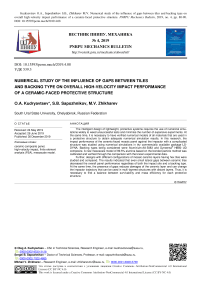Numerical study of the influence of gaps between tiles and backing type on overall high-velocity impact performance of a ceramic-faced protective structure
Автор: Kudryavtsev O.A., Sapozhnikov S.B., Zhikharev M.V.
Статья в выпуске: 4, 2019 года.
Бесплатный доступ
The intelligent design of lightweight, protective systems requires the use of numerical simulations widely to weed unsuccessful tests and minimise the number of expensive experiments. At the same time, it is necessary to have verified numerical models of all materials that are used in a protective structure to obtain adequate numerical simulation results. In this research, the impact performance of the ceramic-faced mosaic panel against the impactor with a complicated structure was studied using numerical simulations in thу commercially available package LS-DYNA. Backing types being considered were Aluminium AA 5083 and Dyneema® HB80 UD composite. A new mesoscale model of 99.5% alumina based on the bonded particle method was calibrated and verified through the comparison with the known experimental data. Further, designs with different configurations of mosaic ceramic layers having hex tiles were studied and compared. The results indicated that even small lateral gaps between ceramic tiles decreased the overall panel performance regardless of both the impact site and a backing type. At the same time, the presence of gaps reduces damages of the ceramic layer and can change the impactor trajectory that can be used in multi-layered structures with distant layers. Thus, it is necessary to find a balance between survivability and mass efficiency for each protective structure.
Ceramic composite panel, high-velocity impact, finite element analysis (fea), mesoscale model
Короткий адрес: https://sciup.org/146281972
IDR: 146281972 | УДК: 539.3 | DOI: 10.15593/perm.mech/2019.4.08
Список литературы Numerical study of the influence of gaps between tiles and backing type on overall high-velocity impact performance of a ceramic-faced protective structure
- Florence A.L. Interaction of projectiles and composite panel - Part I, Report AMRA CR 67-05 (F). Stanford Research Institute, 1967.
- Florence A.L. Interaction of projectiles and composite panel - Part II, Report AMRA CR 67-05 (F). Stanford Research Institute, 1969.
- Wilkins M.L., Honodel C.A., Swale D. An approach to the study of light armor. Livermore: Lawrence Radiation Laboratory; June 1967. UCRL-50284.
- Wilkins M.L., Cline C.F., Honodel C.A. Fourth progress report of light panel program (Report UCRL-50694). Livermore: Lawrence Radiation Laboratory, University of California, 1969.
- Wilkins M.L. Mechanics of penetration and perforation. International Journal of Engineering Science. 1978, vol. 16, pp. 793-807.


